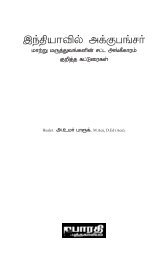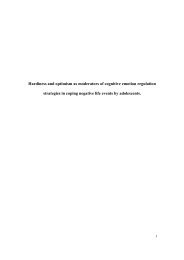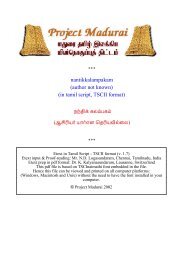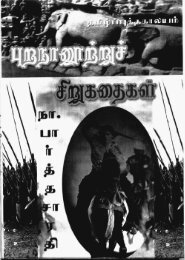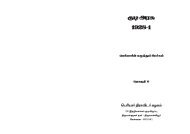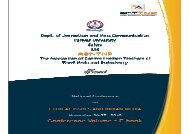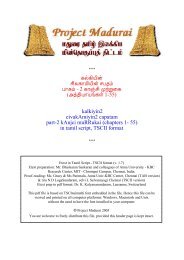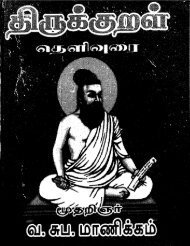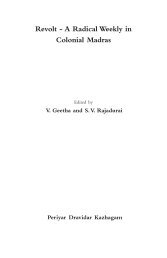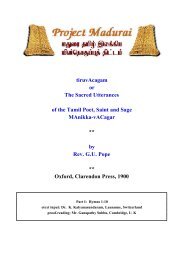Effects of Vethathiri Maharishi's Kaya Kalpa Technique and ...
Effects of Vethathiri Maharishi's Kaya Kalpa Technique and ...
Effects of Vethathiri Maharishi's Kaya Kalpa Technique and ...
- No tags were found...
You also want an ePaper? Increase the reach of your titles
YUMPU automatically turns print PDFs into web optimized ePapers that Google loves.
: | - 01: - 01 | 2013<br />
<strong>Effects</strong> <strong>of</strong> <strong>Vethathiri</strong> Maharishi’s <strong>Kaya</strong> <strong>Kalpa</strong> <strong>Technique</strong> <strong>and</strong><br />
Simplified Physical Exercise (Maharasana) Program for the<br />
Management <strong>of</strong> Type-2 Diabetes Mellitus- a Pilot Trial<br />
Dr.V.M.Rajasekaran, Research Scholar, Bharathiar University, Coimbatore,<br />
Tamil Nadu, India.<br />
Introduction<br />
"By sublimating <strong>and</strong> recycling<br />
The sexual vital fluid<br />
<strong>Kaya</strong> kalpa frees you from<br />
A variety <strong>of</strong> earth bound ills<br />
Your mind develops strength<br />
And Contentment comes to stay<br />
Charity,Compassion<br />
And chastity-Consciousness<br />
patience,Forgiveness.<br />
And acuity <strong>of</strong> intellect,<br />
All these become part<br />
Of your nature <strong>and</strong> being<br />
Yours thought gets oriented<br />
To the absolute directly<br />
And fears <strong>of</strong> death withers<br />
In the effulgence <strong>of</strong> wisdom"<br />
- Value <strong>of</strong> kayakalpa yoga (Yogiraj<br />
<strong>Vethathiri</strong> Maharishi).<br />
Disease, old age, <strong>and</strong> death are<br />
the three major problems which have<br />
been engaging the attention <strong>of</strong> medical<br />
scientists for centuries, <strong>and</strong> in a<br />
different way, that <strong>of</strong> philosophers as<br />
well. Swamiji vethathiri maharishi<br />
founded the simplified Kundalini<br />
Yoga for the benefit <strong>of</strong> humanity. This<br />
aim was to bring about peace around<br />
the<br />
world. A good healthy body awakens<br />
the good soul within us. This helps to<br />
maintain peace in <strong>and</strong> around each<br />
individual which finally helps to<br />
achieve, the goal <strong>of</strong> SKY trust. For<br />
this, swamiji introduced a different<br />
yogic technique that <strong>Kaya</strong> kalpa<br />
(<strong>Kaya</strong> means body <strong>and</strong> <strong>Kalpa</strong> means<br />
immortal <strong>of</strong> physical body) <strong>and</strong><br />
simplified physical exercises<br />
(maharasana) technique <strong>and</strong> It is a<br />
rejuvenating technique. This was once<br />
again brought back by <strong>Vethathiri</strong><br />
maharishi swamiji in an easily<br />
underst<strong>and</strong>able way. This technique is<br />
to rejuvenate the human health that<br />
prevents the aging process.<br />
Diabetes<br />
Diabetes Mellitus is metabolic<br />
cum vascular syndrome <strong>of</strong> multiple<br />
etiologies characterized by chronic<br />
hyperglycemia with disturbance <strong>of</strong><br />
carbohydrates, fat <strong>and</strong> protein<br />
metabolism resulting from effects in<br />
insulin secretion, insulin action or<br />
both. This disorder is frequently<br />
associated with long term damage,<br />
which can lead to failure <strong>of</strong> organs<br />
like eyes, kidneys, nerves, heart <strong>and</strong><br />
10 <strong>Effects</strong> <strong>of</strong> <strong>Vethathiri</strong> Maharishi’s <strong>Kaya</strong> <strong>Kalpa</strong> <strong>Technique</strong> <strong>and</strong> Simplified Physical Exercise<br />
(Maharasana) Program for the Management <strong>of</strong> Type-2 Diabetes Mellitus- a Pilot Trial |<br />
Dr.V.M.Rajasekaran.
: | - 01: - 01 | 2013<br />
blood vessels. Most affected patients<br />
(90%) have type II diabetes, a chronic<br />
progressive disease characterized by<br />
insulin resistance due to abdominal<br />
obesity <strong>and</strong> relative insulin deficiency<br />
due to progressive deterioration <strong>of</strong><br />
pancreatic beta-cell function. Many<br />
years <strong>of</strong> pre-diabetes or impaired<br />
glucose tolerance precede the onset <strong>of</strong><br />
the disease, <strong>and</strong> intensive lifestyle<br />
modification or pharmacotherapy may<br />
prevent the progression to type II<br />
diabetes.<br />
The prevalence <strong>of</strong> diabetes<br />
mellitus is expected to double over the<br />
next 20 years, based on aging <strong>of</strong> the<br />
population <strong>and</strong> the rate <strong>of</strong><br />
urbanization; this increase will be seen<br />
worldwide, in developed as well as in<br />
developing countries, <strong>and</strong> will create<br />
an additional financial <strong>and</strong> social<br />
burden on the public health sector.<br />
Over centuries man has<br />
discovered that through suitable<br />
physical exercises, he can decrease his<br />
blood glucose level so that he may<br />
guard against ill health. The purpose<br />
<strong>of</strong> this study were to assess the signs<br />
<strong>and</strong> symptoms <strong>of</strong> type II diabetes i.e.,<br />
BP, <strong>and</strong> HbA1C, blood glucose levels,<br />
among diabetic patients through a 12<br />
week VETHATHIRI MAHARISHI`S<br />
kaya kalpa technique <strong>and</strong> simplified<br />
physical exercises (maharasana)<br />
program.<br />
Methods <strong>of</strong> Design <strong>and</strong> Setting.<br />
This study used a single group,<br />
open labeled controlled trial design.<br />
After Human Subjects Committee’s<br />
approval was obtained, participants<br />
were recruited via messages that were<br />
delivered to old patients, flyers posted<br />
in hospital outpatient waiting rooms.<br />
To be eligible, participants had to be<br />
between 40 <strong>and</strong> 65 years <strong>of</strong> age, nonexercisers<br />
for the previous 12 months,<br />
<strong>and</strong> they had impaired fasting glucose<br />
(FBG >125 mg/dl)<strong>and</strong> postpr<strong>and</strong>ial<br />
glucose (PPBG >160mg/dl);<br />
hypertension (systolic BP/diastolic<br />
BP: above 120/above 80 mmHg).<br />
Persons who were pregnant, those<br />
who had used any drug to reduce their<br />
blood cholesterol level, BP or glucose,<br />
or those who had a physical disability<br />
that would limit their ability to<br />
practice yoga were excluded from the<br />
study.<br />
We confirmed their eligibility with<br />
screening tests for glucose <strong>and</strong> BP at<br />
the Jothi siddha clinic <strong>and</strong> laboratory.<br />
A copy <strong>of</strong> the consent form was sent<br />
for their review prior to their<br />
screening visit to the clinic. We<br />
reviewed the study details described in<br />
the consent form with them in person<br />
<strong>and</strong> responded to their questions<br />
before they signed the consent form.<br />
Fifteen participants were directly<br />
assigned to a Maharishi yoga<br />
intervention group.<br />
11 <strong>Effects</strong> <strong>of</strong> <strong>Vethathiri</strong> Maharishi’s <strong>Kaya</strong> <strong>Kalpa</strong> <strong>Technique</strong> <strong>and</strong> Simplified Physical Exercise<br />
(Maharasana) Program for the Management <strong>of</strong> Type-2 Diabetes Mellitus- a Pilot Trial |<br />
Dr.V.M.Rajasekaran.
: | - 01: - 01 | 2013<br />
Intervention (or Experimental<br />
Procedure)<br />
Participants in the intervention<br />
group were asked to maintain their<br />
current activity levels during the<br />
intervention. The intervention group<br />
participated in a 3- month <strong>Vethathiri</strong><br />
Maharishi’s style <strong>of</strong> yoga practice<br />
intervention program developed <strong>and</strong><br />
led by a certified yoga instructor in the<br />
temple <strong>of</strong> consciousness a, Aliyar<br />
(Coimbatore district), Tamil Nadu.<br />
Steps in <strong>Kaya</strong>kalpa <strong>Technique</strong><br />
1. Toning up <strong>of</strong> nerves.<br />
2. Ojus breathe.<br />
There are two aspects<br />
maharasana exercises: In part A <strong>of</strong><br />
makarasana the basic posture is lying<br />
down flat on the back.<br />
In part B <strong>of</strong> makarasana the basic<br />
position is lying on one`s stomach.<br />
All postures were modified to<br />
meet the participants’ needs <strong>and</strong> to<br />
assure safety. Each session <strong>of</strong> the yoga<br />
program began with a warm-up (5<br />
min) <strong>and</strong> ended with a relaxation<br />
period (10 min). To facilitate <strong>and</strong><br />
guide home practice, participants were<br />
given an audio recording (CD) <strong>of</strong> the<br />
yoga instructions recorded by the yoga<br />
instructor. Group sessions were held<br />
twice per week. Participants were<br />
expected to practice yoga at home <strong>and</strong><br />
record the number <strong>of</strong> minutes they<br />
engaged in yoga per day, but there<br />
was no certain amount or frequency<br />
required. The components <strong>of</strong> our<br />
intervention using <strong>Vethathiri</strong><br />
Maharishi’s style yoga are detailed<br />
above.<br />
Measures<br />
Clinical Measures<br />
Blood Pressure, blood glucose<br />
<strong>and</strong> HbA1C were obtained at baseline<br />
<strong>and</strong> at the end <strong>of</strong> 3 months. The blood<br />
test required a 12-h fast (no food or<br />
drink, except water <strong>and</strong> medications);<br />
20 ml <strong>of</strong> blood was obtained via a<br />
venipuncture in the arm with the<br />
individual in an upright position <strong>and</strong><br />
after at least 5min in a resting state.<br />
During the measurements, we<br />
were available to answer any<br />
questions <strong>and</strong> participants were asked<br />
not to discuss their program with the<br />
clinic staff. Participants were asked to<br />
describe their demographic <strong>and</strong> comorbidity<br />
pr<strong>of</strong>ile at baseline <strong>and</strong><br />
complete questionnaires on exercise<br />
self-efficacy at baseline <strong>and</strong> at the end<br />
<strong>of</strong> 3 months.<br />
Acceptability <strong>of</strong> the yoga<br />
intervention was evaluated at the end<br />
<strong>of</strong> the yoga intervention by the Yoga<br />
Program Satisfaction Questionnaire.<br />
Analysis<br />
Statistical analyses were<br />
performed<br />
with SPSS version 12.0 for Windows.<br />
We used the paired t-test to determine<br />
within-group differences <strong>of</strong><br />
biochemical parameters before<br />
12 <strong>Effects</strong> <strong>of</strong> <strong>Vethathiri</strong> Maharishi’s <strong>Kaya</strong> <strong>Kalpa</strong> <strong>Technique</strong> <strong>and</strong> Simplified Physical Exercise<br />
(Maharasana) Program for the Management <strong>of</strong> Type-2 Diabetes Mellitus- a Pilot Trial |<br />
Dr.V.M.Rajasekaran.
: | - 01: - 01 | 2013<br />
(baseline) <strong>and</strong> after the intervention.<br />
For descriptive purposes, the results<br />
are expressed as untransformed <strong>and</strong><br />
unadjusted mean values. Continuous<br />
variables are expressed as mean ± SD,<br />
<strong>and</strong> categorical variables are<br />
expressed as absolute numbers. A<br />
two-tailed value <strong>of</strong> P less than 0.05<br />
was considered significant.<br />
Results<br />
15 subjects enrolled in this<br />
study Table.1 shown the description<br />
<strong>of</strong> subjects. All subjects completed the<br />
studies. Clinically significant<br />
differences were observed between<br />
the baseline <strong>and</strong> day90. Mean Fasting<br />
blood glucose, postpr<strong>and</strong>ial glucose,<br />
HbA1c, Blood pressure values at<br />
screening were baseline <strong>and</strong> day90.<br />
In this study, statistically<br />
significantly greater (P ≤ 0.001) mean<br />
decreases from baseline to day 90<br />
were observed in the group for Fasting<br />
blood glucose 115.1± 11.5 to<br />
92.8±11.7, postpr<strong>and</strong>ial glucose<br />
203±12.5 to 178±11.5, HbA1c 8±1.2<br />
to 6±0.8, Blood pressure Systolic<br />
141±5 to 121.5±5.5 <strong>and</strong> Diastolic<br />
85±4.2 to 80±2.5 see Table.2.<br />
Descriptive Statistics<br />
Patients Frequency Percent<br />
Female 8 53.34<br />
Male 7 46.66<br />
Mean Age 45 100.00<br />
Table: 1<br />
Outcomes<br />
Fasting<br />
blood<br />
glucose<br />
postpr<strong>and</strong>ial<br />
glucose<br />
Before<br />
Treatment<br />
(sd)<br />
After<br />
Treatment<br />
(sd)<br />
115.1± 11.5 92.8±11.7<br />
203±12.5 178±11.<br />
HbA1c 8±1.2 6±0.8<br />
Blood<br />
pressure<br />
Systolic<br />
Blood<br />
pressure<br />
Diastolic<br />
Table: 2<br />
141±5 121.5±5.5<br />
85±4.2 80±2.5<br />
Discussion <strong>and</strong> Conclusion<br />
This pilot study assessed the<br />
feasibility <strong>of</strong> implementing <strong>Vethathiri</strong><br />
Maharishi’s yoga program among<br />
adults at type 2 diabetes. The<br />
preliminary study results indicate that<br />
this yoga program is feasible <strong>and</strong><br />
acceptable to this population.<br />
Participants in the yoga group showed<br />
increased confidence over time in<br />
recommending the yoga program to<br />
their friends who are at high risk for<br />
type 2 Diabetes <strong>and</strong> expressed high<br />
satisfaction with the program. There<br />
was significant decrease in FBS,<br />
PPBS, HbA1c values in both sex who<br />
underwent the 3 months yoga <strong>and</strong><br />
<strong>Kaya</strong>kalpa practice. As participants<br />
13 <strong>Effects</strong> <strong>of</strong> <strong>Vethathiri</strong> Maharishi’s <strong>Kaya</strong> <strong>Kalpa</strong> <strong>Technique</strong> <strong>and</strong> Simplified Physical Exercise<br />
(Maharasana) Program for the Management <strong>of</strong> Type-2 Diabetes Mellitus- a Pilot Trial |<br />
Dr.V.M.Rajasekaran.
: | - 01: - 01 | 2013<br />
were asked not to change their<br />
exercise level by initiating any new<br />
form <strong>of</strong> exercise during this study, we<br />
limited our recommendations for<br />
physical activity to emphasizing the<br />
importance <strong>of</strong> being active in daytoday<br />
life.<br />
Addition to all above effects,<br />
following simplified exercise <strong>and</strong><br />
<strong>Kaya</strong>kalpa yoga, many patients<br />
reported a feeling <strong>of</strong> well-being, more<br />
relaxed <strong>and</strong> satisfied, <strong>and</strong> a sense <strong>of</strong><br />
relief from anxiety. While the small<br />
sample limits the generalizability <strong>of</strong><br />
our findings, the r<strong>and</strong>omized,<br />
controlled trial design helps to better<br />
underst<strong>and</strong> the benefits <strong>of</strong> the<br />
intervention program, because such a<br />
design permits allocation <strong>of</strong><br />
participants that minimizes any bias<br />
from known <strong>and</strong> unknown<br />
determinants <strong>of</strong> outcome.<br />
In summary, the results <strong>of</strong> this<br />
pilot study suggest that this yoga<br />
program could potentially be a<br />
reduction option for hyperglycemia on<br />
type 2 diabetes patients. Anecdotal<br />
comments by study participants<br />
revealed that they perceived<br />
improvement in their strength,<br />
flexibility <strong>and</strong> balance after practicing<br />
yoga. We recommend that future<br />
studies involving Vethathri<br />
Maharishi’s yoga obtain objective<br />
measures <strong>of</strong> hormones, blood sugar<br />
<strong>and</strong> other metabolic activity related to<br />
diabetes.<br />
14 <strong>Effects</strong> <strong>of</strong> <strong>Vethathiri</strong> Maharishi’s <strong>Kaya</strong> <strong>Kalpa</strong> <strong>Technique</strong> <strong>and</strong> Simplified Physical Exercise<br />
(Maharasana) Program for the Management <strong>of</strong> Type-2 Diabetes Mellitus- a Pilot Trial |<br />
---<br />
Key words: <strong>Vethathiri</strong> Maharishi, <strong>Kaya</strong><br />
<strong>Kalpa</strong> <strong>Technique</strong>, Simplified Physical<br />
Exercise, Maharasana, Type-2 Diabetes<br />
Mellitus<br />
Dr.V.M.Rajasekaran.



